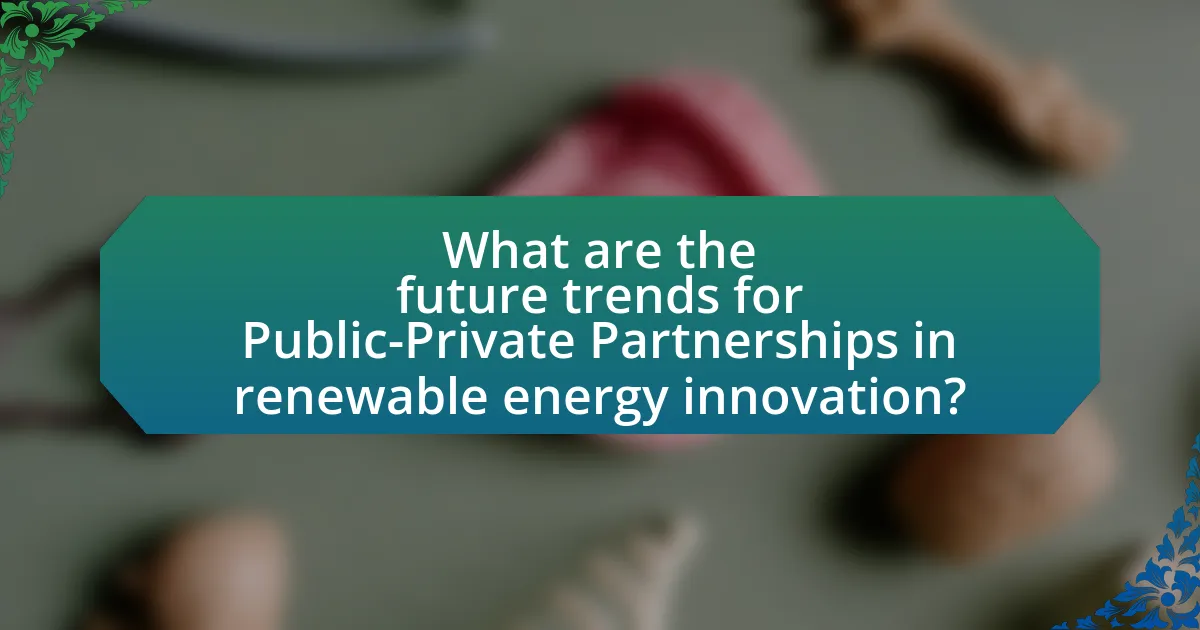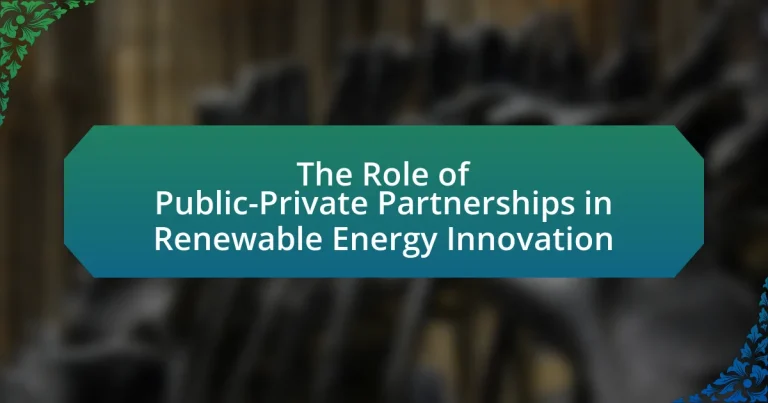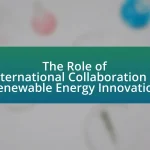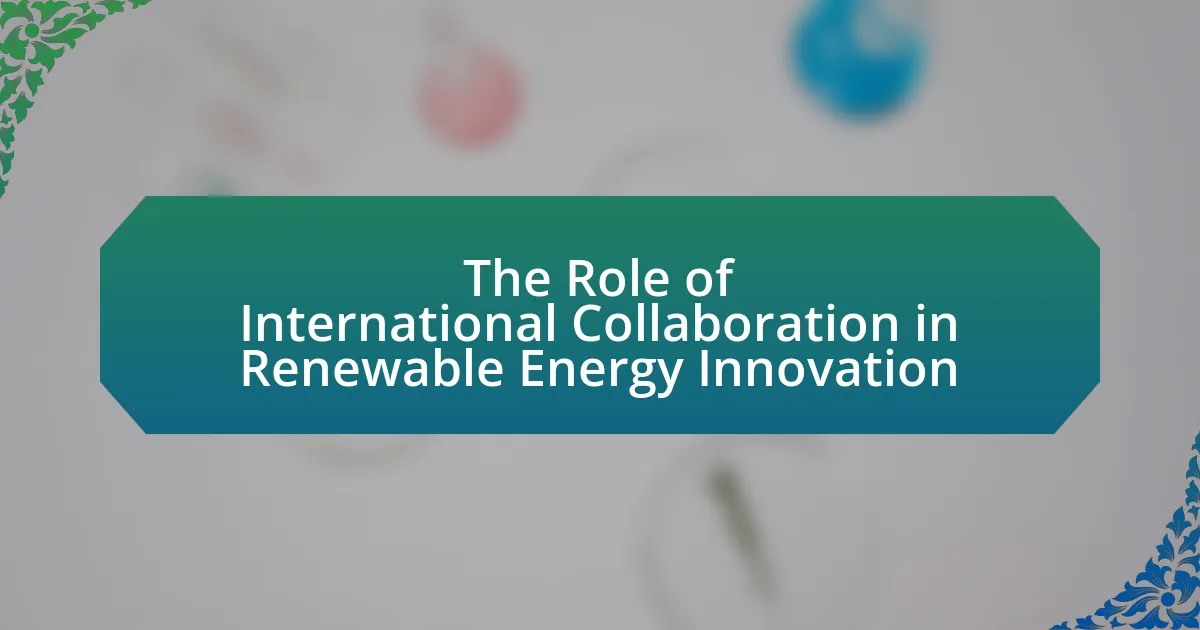Public-Private Partnerships (PPPs) play a crucial role in renewable energy innovation by facilitating collaboration between government entities and private sector companies. These partnerships combine public resources, regulatory support, and funding with private investment, technological expertise, and operational efficiency to accelerate the development and deployment of renewable energy projects. The article explores how PPPs function, the roles of public and private entities, the economic benefits they provide, and the challenges they face, including regulatory issues and financial constraints. Additionally, it highlights best practices for enhancing collaboration and discusses future trends in technology and data sharing that can maximize the impact of these partnerships in achieving sustainable energy solutions.

What are Public-Private Partnerships in Renewable Energy Innovation?
Public-Private Partnerships (PPPs) in renewable energy innovation are collaborative agreements between government entities and private sector companies aimed at developing and implementing renewable energy projects. These partnerships leverage the strengths of both sectors, where public entities provide regulatory support, funding, and infrastructure, while private companies contribute technological expertise, efficiency, and investment capital. For instance, the U.S. Department of Energy has engaged in PPPs to advance solar and wind technologies, demonstrating the effectiveness of such collaborations in accelerating innovation and deployment in the renewable energy sector.
How do Public-Private Partnerships function in the renewable energy sector?
Public-Private Partnerships (PPPs) in the renewable energy sector function by combining resources, expertise, and risk-sharing between government entities and private companies to develop and implement renewable energy projects. These collaborations enable the mobilization of private investment and innovation while leveraging public support and regulatory frameworks. For instance, the U.S. Department of Energy has engaged in PPPs to advance solar energy technologies, resulting in significant cost reductions and increased deployment of solar systems. This model has proven effective in various countries, where PPPs have facilitated the construction of wind farms and solar plants, demonstrating the ability to accelerate project timelines and enhance efficiency through shared responsibilities.
What roles do public entities play in these partnerships?
Public entities play crucial roles in public-private partnerships (PPPs) within renewable energy innovation by providing regulatory frameworks, funding, and facilitating collaboration. They establish policies that create a conducive environment for private investment, ensuring compliance with environmental standards and promoting sustainable practices. Additionally, public entities often contribute financial resources or incentives, such as grants or tax credits, to stimulate private sector involvement. For instance, government initiatives like the U.S. Department of Energy’s Loan Programs Office have supported numerous renewable energy projects, demonstrating the effectiveness of public funding in leveraging private investment. Furthermore, public entities act as coordinators, bringing together various stakeholders, including private companies, research institutions, and community organizations, to foster innovation and share knowledge. This collaborative approach enhances the development and deployment of renewable energy technologies, ultimately contributing to energy transition goals.
What roles do private entities play in these partnerships?
Private entities in public-private partnerships for renewable energy innovation primarily provide funding, technological expertise, and operational efficiency. These companies invest capital to develop renewable energy projects, which can significantly reduce the financial burden on public entities. For instance, in the United States, private firms have contributed over $100 billion in renewable energy investments from 2008 to 2018, facilitating the growth of solar and wind energy sectors. Additionally, private entities often bring advanced technologies and innovative practices that enhance project implementation and efficiency, as seen in partnerships like the Solar Energy Innovation Network, where private companies collaborate with public institutions to accelerate solar technology deployment.
Why are Public-Private Partnerships important for renewable energy innovation?
Public-Private Partnerships (PPPs) are crucial for renewable energy innovation because they leverage the strengths of both sectors to accelerate development and deployment of clean technologies. These collaborations combine public sector resources and regulatory support with private sector efficiency, investment, and innovation capabilities. For instance, the International Renewable Energy Agency reported that PPPs have facilitated significant advancements in solar and wind energy projects, leading to a 70% reduction in solar costs over the past decade. This synergy not only enhances funding opportunities but also fosters knowledge sharing and risk mitigation, ultimately driving the transition to sustainable energy solutions.
How do these partnerships drive technological advancements?
Public-private partnerships drive technological advancements by facilitating resource sharing, risk mitigation, and collaborative innovation in renewable energy projects. These partnerships combine the strengths of public entities, such as regulatory support and funding, with the private sector’s expertise in technology development and market implementation. For instance, the collaboration between the U.S. Department of Energy and private companies has led to significant advancements in solar energy technologies, resulting in a 90% reduction in the cost of solar photovoltaic systems since 2009. This synergy accelerates research and development, leading to faster deployment of innovative solutions that enhance efficiency and sustainability in renewable energy.
What economic benefits do Public-Private Partnerships provide?
Public-Private Partnerships (PPPs) provide significant economic benefits, including increased investment efficiency, risk sharing, and enhanced innovation. By leveraging private sector capital and expertise, PPPs can reduce the financial burden on public entities while accelerating project delivery. For instance, a study by the World Bank indicates that PPPs can lead to cost savings of 20-30% in infrastructure projects compared to traditional public procurement methods. Additionally, PPPs foster innovation by encouraging private companies to develop new technologies and solutions, particularly in renewable energy sectors, where collaboration can lead to more sustainable practices and reduced operational costs.

What challenges do Public-Private Partnerships face in renewable energy innovation?
Public-Private Partnerships (PPPs) in renewable energy innovation face several significant challenges, including misaligned objectives, regulatory hurdles, and financing difficulties. Misaligned objectives occur when public entities prioritize social or environmental goals while private partners focus on profitability, leading to conflicts in project execution. Regulatory hurdles arise from complex and often changing policies that can create uncertainty for investors and slow down project development. Financing difficulties stem from the high upfront costs associated with renewable energy projects, which can deter private investment without adequate public support or incentives. These challenges hinder the effective collaboration necessary for advancing renewable energy technologies and achieving sustainability goals.
What are the common barriers to successful collaboration?
Common barriers to successful collaboration include misaligned goals, lack of trust, and inadequate communication. Misaligned goals occur when public and private partners have different objectives, leading to conflicts and inefficiencies. Lack of trust can hinder open dialogue and information sharing, which are essential for effective collaboration. Inadequate communication often results in misunderstandings and delays, further complicating partnership dynamics. Research by the World Economic Forum highlights that these barriers can significantly impede the effectiveness of public-private partnerships, particularly in sectors like renewable energy, where collaboration is crucial for innovation and implementation.
How do regulatory issues impact Public-Private Partnerships?
Regulatory issues significantly impact Public-Private Partnerships (PPPs) by influencing project feasibility, funding, and operational frameworks. These regulations can dictate the terms under which private entities collaborate with public agencies, affecting everything from compliance costs to risk allocation. For instance, stringent environmental regulations may require additional investments in technology or processes, thereby altering the financial viability of renewable energy projects. Additionally, regulatory uncertainty can deter private investment, as seen in the fluctuating policies surrounding renewable energy incentives in various countries, which can lead to hesitance among investors. Thus, the regulatory landscape plays a crucial role in shaping the success and sustainability of PPPs in the renewable energy sector.
What financial challenges do these partnerships encounter?
Public-private partnerships in renewable energy innovation encounter several financial challenges, primarily including funding gaps, risk-sharing issues, and fluctuating market conditions. Funding gaps arise when the initial capital required for projects exceeds available resources, often leading to delays or project cancellations. Risk-sharing issues occur as private entities may hesitate to invest due to uncertainties in regulatory frameworks or technology performance, which can deter investment. Fluctuating market conditions, such as changes in energy prices or government incentives, can also impact the financial viability of these partnerships, making it difficult to secure long-term commitments from investors. These challenges are documented in various studies, including the International Renewable Energy Agency’s report on financing renewable energy projects, which highlights the importance of stable policy environments and innovative financing mechanisms to address these issues.
How can these challenges be overcome?
Public-private partnerships can overcome challenges in renewable energy innovation by fostering collaboration between government entities and private companies. This collaboration can lead to shared resources, risk mitigation, and enhanced funding opportunities. For instance, the U.S. Department of Energy’s SunShot Initiative successfully partnered with private firms to reduce solar energy costs by 75% between 2010 and 2020, demonstrating the effectiveness of such partnerships in driving innovation and reducing barriers. By aligning goals and pooling expertise, these partnerships can effectively address regulatory hurdles, financial constraints, and technological limitations in the renewable energy sector.
What best practices can enhance collaboration between public and private sectors?
Establishing clear communication channels is a best practice that can significantly enhance collaboration between public and private sectors. Effective communication fosters transparency, aligns objectives, and builds trust among stakeholders. For instance, the U.S. Department of Energy’s Solar Energy Technologies Office emphasizes the importance of regular stakeholder meetings and updates to ensure all parties are informed and engaged in the decision-making process. Additionally, creating joint task forces or working groups can facilitate the sharing of expertise and resources, leading to more innovative solutions in renewable energy projects. Research indicates that successful public-private partnerships often involve structured frameworks for collaboration, such as defined roles and responsibilities, which help streamline efforts and improve outcomes.

What are the future trends for Public-Private Partnerships in renewable energy innovation?
Future trends for Public-Private Partnerships (PPPs) in renewable energy innovation include increased collaboration on technology development, enhanced financing mechanisms, and a focus on sustainability and climate resilience. These partnerships are expected to leverage private sector efficiency and innovation while utilizing public sector support and regulatory frameworks to accelerate the deployment of renewable technologies. For instance, the International Renewable Energy Agency (IRENA) reported that investments in renewable energy are projected to reach $2 trillion annually by 2030, highlighting the critical role of PPPs in mobilizing capital and expertise. Additionally, as governments aim for net-zero emissions, PPPs will likely prioritize projects that integrate renewable energy with smart grid technologies and energy storage solutions, further driving innovation in the sector.
How is technology shaping the future of these partnerships?
Technology is shaping the future of public-private partnerships in renewable energy innovation by enhancing collaboration, improving efficiency, and enabling data-driven decision-making. Advanced technologies such as artificial intelligence, blockchain, and the Internet of Things facilitate real-time data sharing and transparency between public and private entities, leading to more effective project management and resource allocation. For instance, a study by the International Renewable Energy Agency (IRENA) highlights that digital tools can reduce project costs by up to 30% and accelerate deployment timelines, thereby fostering a more dynamic partnership environment. Additionally, technology enables innovative financing models, such as crowdfunding and green bonds, which attract diverse investments and support sustainable energy initiatives.
What role does digitalization play in enhancing collaboration?
Digitalization significantly enhances collaboration by facilitating real-time communication and data sharing among stakeholders. This transformation allows public and private entities in renewable energy to work together more efficiently, breaking down geographical barriers and enabling instant access to critical information. For instance, platforms like cloud computing and collaborative software tools enable teams to coordinate projects seamlessly, leading to faster decision-making and innovation. Research indicates that organizations leveraging digital tools can improve project delivery times by up to 30%, demonstrating the tangible benefits of digitalization in collaborative efforts within the renewable energy sector.
How can data sharing improve outcomes in Public-Private Partnerships?
Data sharing can significantly improve outcomes in Public-Private Partnerships (PPPs) by enhancing collaboration, increasing transparency, and facilitating informed decision-making. When public and private entities share data, they can align their goals and resources more effectively, leading to optimized project execution and innovation in renewable energy. For instance, a study by the World Economic Forum highlights that data sharing in energy projects can reduce costs by up to 30% and accelerate project timelines by providing real-time insights into performance and resource allocation. This collaborative approach fosters trust and accountability, ultimately driving better results in renewable energy initiatives.
What strategies can be employed to maximize the impact of Public-Private Partnerships?
To maximize the impact of Public-Private Partnerships (PPPs) in renewable energy innovation, stakeholders should focus on aligning objectives, fostering transparent communication, and ensuring equitable risk-sharing. Aligning objectives between public entities and private partners ensures that both parties work towards common goals, enhancing project efficiency and effectiveness. Transparent communication facilitates trust and collaboration, which are essential for addressing challenges and adapting to changing circumstances. Additionally, equitable risk-sharing distributes responsibilities and financial burdens, encouraging private investment while protecting public interests. Evidence from successful PPPs in renewable energy, such as the Solar Energy Development Program in California, demonstrates that these strategies lead to increased project success rates and innovation outcomes.
What are the key factors for successful long-term partnerships?
Successful long-term partnerships are primarily driven by trust, clear communication, and shared goals. Trust fosters a reliable environment where partners can collaborate effectively, while clear communication ensures that all parties are aligned on expectations and responsibilities. Shared goals create a unified vision, motivating partners to work together towards common objectives. Research indicates that partnerships with these characteristics are more likely to achieve sustainable outcomes, as evidenced by studies showing that organizations with high trust levels report 50% higher performance metrics in collaborative projects.
What practical steps can organizations take to engage in effective Public-Private Partnerships?
Organizations can engage in effective Public-Private Partnerships (PPPs) by establishing clear objectives and aligning interests between public and private sectors. This involves conducting thorough stakeholder analysis to identify key players and their motivations, ensuring that both parties have a shared vision for the partnership.
Additionally, organizations should develop a robust governance framework that outlines roles, responsibilities, and decision-making processes, which enhances transparency and accountability. Implementing risk-sharing mechanisms is also crucial, as it allows both sectors to collaboratively manage financial and operational risks associated with renewable energy projects.
Furthermore, organizations can foster open communication channels to facilitate ongoing dialogue and feedback, which is essential for adapting to changing circumstances and maintaining stakeholder engagement. Evidence from successful PPPs in renewable energy, such as the collaboration between the U.S. Department of Energy and private firms in solar energy initiatives, demonstrates that these steps lead to more innovative and sustainable outcomes.




